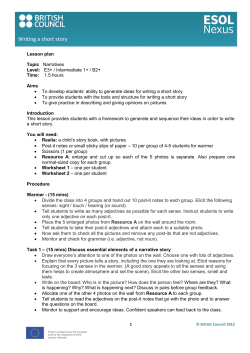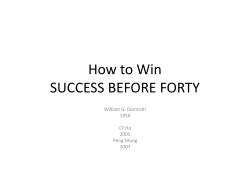
Experience Economy How to survive in the 21
Experience Economy How to survive in the 21st century Experience Economy Agenda: • Background for the development: From commodity to experience • Indirect use of experiences: Experience as value adding • Experience process • Selling pure experiences: Using the experience realm model • How to develop experiences • Creating the experience settings Background for the development: From commodity to experience Historical development • Alvin Toffler: First author to define the concept In ”Future Shock” from 1970: ”From a system designed to provide material satisfaction, we are rapidly creating a new economy geared to the provision of psychic gratification” • Gerhard Schultze describes a development in society based on experiences, hobbies and values in “Erleibnisgemeinschaft” in 1992 • First management book in 1999: The experience Economy” by Joseph Pine & James Gillmore The Pine & Gillmore contribution • Presenting a business view on the experience concept (and a way to avoid commoditization) • Introducing experiences as a source of economic value • Separating services and experiences • Using a theatre metaphor to explain their points • Providing tools to identify and develop experiences Their definition: Companies stage meaningful events to engage customers in a memorable and personal way Why now? 1. Rising consumer demands: - Rising Brand awareness - Politically correct consumer (environment; production ethics) - Personalization (self-staging) 2. Commoditization: Increasing focus on price (Internet; discount wave; growing competition) 3. Increasing wealth Economical progression • A commodity business charges for undifferentiated products. • A goods business charges for distinctive, tangible things. • A service business charges for the activities you perform. • An experience business charges for the feeling customers get by engaging it From commodity to experience Indirect use of experience economy: Experience as value adding Producers 1. Direct - the experience is the business idea - theme parks, movies, concerts, tourism, computer games etc. 2. Indirect - experience is added to the physical product (value adding) - Emotional state achieved by owning or using product Tools: branding, story telling, events, customization Indirect use of experience economy Companies need to focus on: • Building a strong Brand • Personalizing products: Customization • Telling a story • Staging events Examples: Branding Self-staging (who-am-I Marketing) • exciting, classy person • feels at ease at the finest hotels in an international environment Events Are you a LEGO Club member who wants to meet other LEGO Club members, participate in fun, themed building activities, and get an exclusive LEGO Club t-shirt? Then come to a LEGO Club meeting at your local LEGO store! Meetings will be held on Saturday mornings and take place in the store before it opens! Examples: Story telling It all started in New York’s Greenwich Village in 1972. Childhood friends Leonard Marsh, Hyman Golden and Arnold Greenburg saw more potential in fruit than just something to throw in the lunchroom. But where did they get the name Snapple? It actually came from a carbonated apple soda that was part of the original beverage line. The soda had a great snappy apple taste. Now that’s cleverness at its best. Fast forward to the era of hair bands and acid-washed jeans. We’re talking 1987, my friends. That’s when Snapple teas were born. Today, Snapple produces more than 50 varieties of teas, juice drinks and flavored waters – all Made from the Best Stuff on Earth. Customization Experience process Rational vs. emotional behavior • The non-rational consumer buys product with an emotional appeal • Brain system: a) reptile brain: controls the instincts b) neo cortex: controls our reason c) limbic system: controls our emotions Experience economy is appealing to the limbic system and silencing neo cortex Proces of experience Sensory perception Emotion Experience (Erlebnis) Meaningful experience (Erfahrung) Give meaning Sensory perception and emotions • Use of the senses in creating experiences (sight, hear, smell, taste, touch) • Hierarchy of senses – useful to establish • Senses lead to emotions (a way of dealing with the world) • Emotions are part of the evaluation process • Mental state has a big impact on emotions Experience and meaningful experience • Experience - a set of emotions - create meaning - is related to the moment • Meaningful experience - learning process of experiences (what it means to me?) - could be compared to post purchase behavior Motivation • Understanding the quest for meaningful experiences • Fridjas model: a) individual (appreciation) vs. collective (recognition) b) control (certainty) vs. discovery (expression) • The consumer will move in this field! Alternative model: Maslows hierarchy of needs Conclusion: Meaningful experience Include the following characteristics: • They involve all senses • High degree of focus and concentration • A loss of time and place • Being emotionally touched • A unique and valuable process • Being in contact with the environment Selling pure experiences: Using the experience realms model (Analyzing the experience) Dimensions An experience can engage customers based on two dimensions: • Degree of customer participation passive - observe, listen; do not affect the experience active – affects and takes part in the experience • Customers relation to the experience absorption – experience ”goes into” the customer immersion – customer ”goes into” the experience The four experience realms Entertainment • Passive absorption of experiences • Using the senses see and listen • Traditional perception of experiences • Entertainment will often be an element of the experience Examples: Concerts; Movies, Sports events Education • Active absorption of knowledge by engaging the intellect or the body (training) • Is often seen as serious experiences (you learn something or is developed physically) • a fusion with entertainment is becoming popular (edutainment) Examples: Fitness, Courses, Museums Escapism • Active immersion; customer becomes part of the experience; the experience can be affected • Customer participates in activities, where you forget about time and place • The most development is seen within this area Examples: Amusement parks; Extreme sport; Gambling; Cyberspace Esthetic • Passive immersion; no influence on the experience • Special moments of enjoyment to remember • The environment is unchanged; only the customer is affected • Is often related to art and nature Major points • Entertainment: Is about sensing • Education: Is about learning • Escapism: Is about doing • Esthetic: Is about being there Objectives: • Expanding the experience by adding more realms • The ultimate experience includes all four realms (the sweet spot) How to develop experiences Five stages of developing experiences 1. Innovation and creativity: Idea stage 2. Developing experience proposition: Design stage 3. Internal processes and core competencies: How it affects organization 4. People and culture: The people who makes it happen 5. The business model: How money is earned Stage 1: Idea stage Objective: Find new concepts; improving existing concepts Creative thinking: break through existing patterns of thinking (“step into lunacy”) Methods: • Brainstorming • Association techniques • Power of imagination Check your ideas with questions on page 171-173 Stage 2: Design stage Pine & Gillmore focus on 5 principles in designing experiences Important principles: 1. Use a theme 2. Use positive cues 3. Avoid negative cues 4. Include memorabilia 5. Engage all five senses • Stage 2: Design stage Another approach is developing on the value chain by creating a customer experience chain (also related to buying process) • Determine the sequences of stages that a customer goes through • Determine needs, considerations, emotions and impressions • Design your offer Stage 2: Design stage Customer experience chain (booking a holiday) 1. Getting the idea (inspiration) 2. Finding information 3. Choosing between options 4. Booking the trip 5. Preparing for the trip 6. Taking the trip 7. Enjoying the memory of the trip 8. Getting a new idea Stage 3: Organizational consequences • The experience chain activities has to be translated into supporting processes (both physical and virtual settings) • The basic processes has to be under complete control • Need competencies to carry out the necessary processes • Technology should support the processes Stage 4: Personnel • Quality of experience depends to a great extent on the contact moments • Important to determine desired behavior from the personnel • Determine the level of freedom (behavior is often controlled and standardized) • Satisfied employees will deliver more value to the customer (motivation factors) Stage 5: Economy • The cost of creating an experience ultimately have to be returned – customers have to be willing to cover the value adding cost • Costs include: development; salaries; physical settings; marketing • Can be hard to calculate as most cost does not relate to one specific experience product Creating the experience settings Designing the setting Important principles: 1. Use a theme 2. Use positive cues 3. Avoid negative cues 4. Include memorabilia 5. Engage all five senses Principle 1: Themes • • • Forms the foundation of a story Scripting a participative story Examples: nostalgia; wild west; Arabian fantasy; urban motif; tropical paradise… Principle 2 & 3: Positive and negative cues • The ”takeaways” of the experience • Leave indelible impressions • Can be divided into: 1) Mechanics: sights, smells, sounds, tastes and textures generated by things 2) Humanics: comes from people; the behavior of employees • Eliminate distractions (like overservicing; long check-in procedures etc.) Principle 4: Memorabilia • Products that creates memories • Are important for the meaningful experience (after the experience is over) • Souvenirs or merchandise: could be an important income factor • Not just for memories; also to show others to generate conversation • Could also be given away Principle 5: Five senses • The more an experience engages the senses, the more memorable it will be • Easiest way: add taste sensations (simply by serving food and drinks) • Be careful not to overwhelm the customer with sensory input – map the effect of each cue on the senses
© Copyright 2025





















